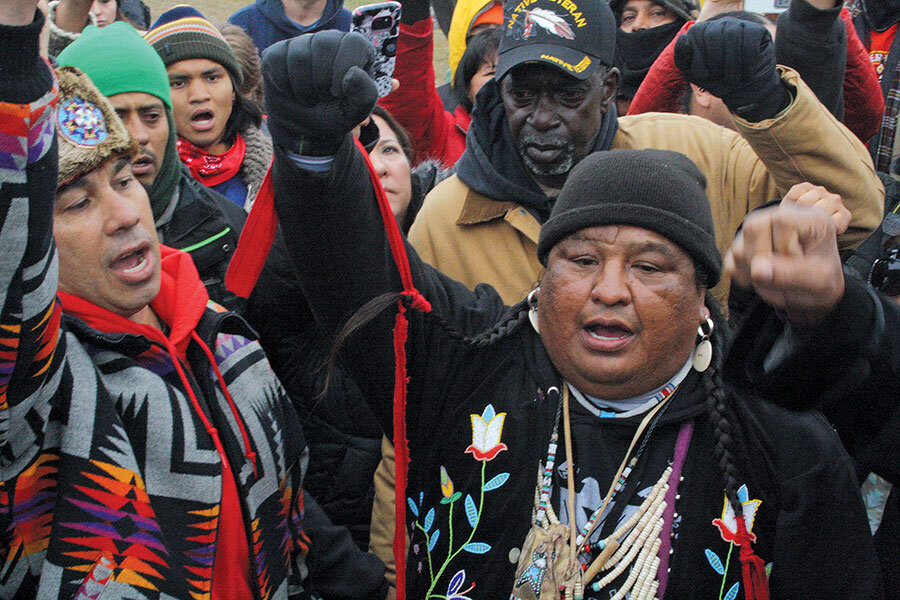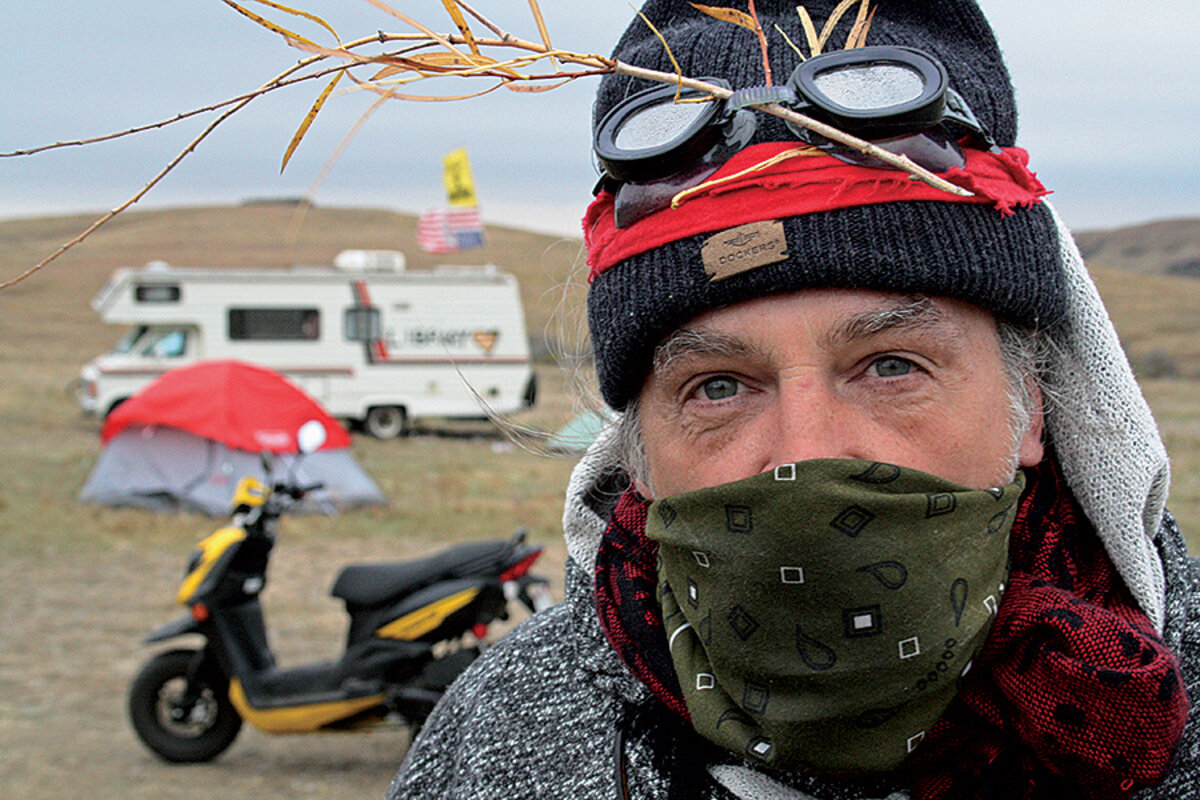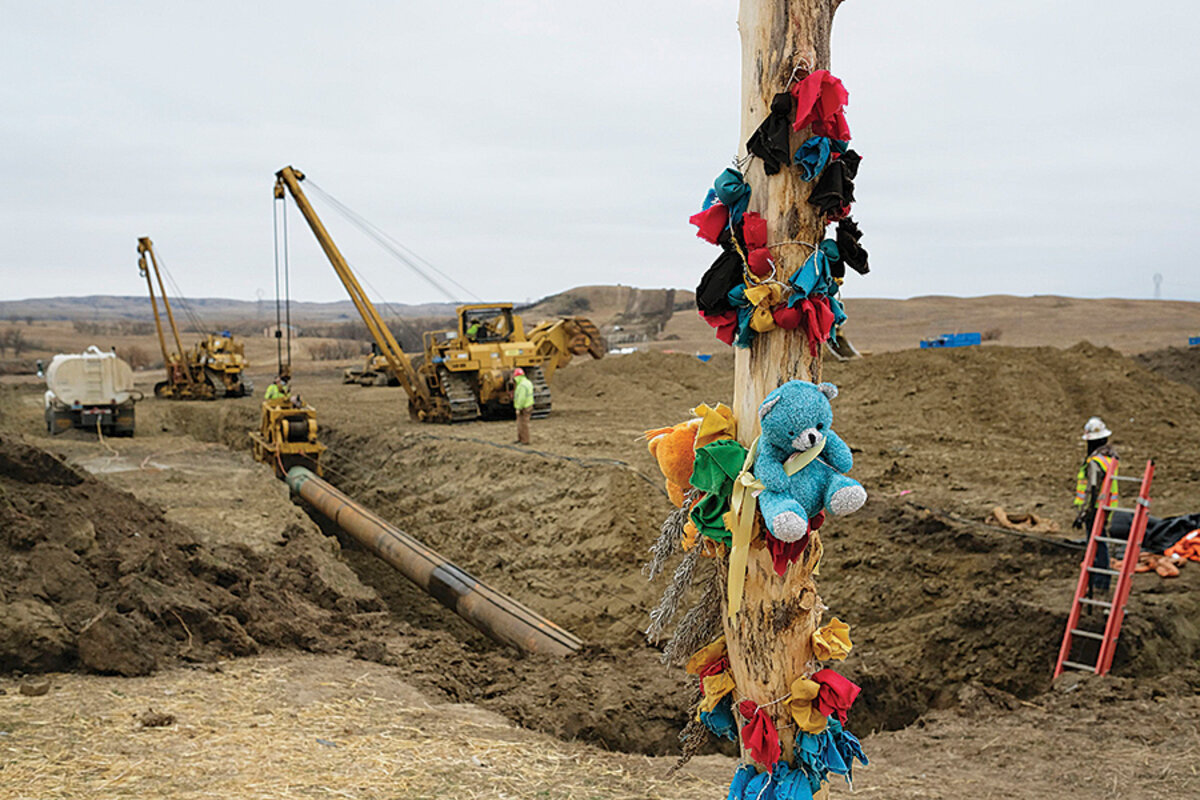For native Americans, pipeline sparks climate awakening
Loading...
| Cannon Ball, N.D.
In Ojibwa and other tribal cultures, a sweat lodge is a place one goes to for healing, prayer, and religious ceremonies. Joseph Hock wanted to use his for that – but also as a blockade.
Wielding a machete one frosty afternoon in late October, the Anishinabek Indian from Michigan whittled long poles from tree branches. Around him, a “frontline” camp was staking itself into the knuckled golden prairie directly between the Dakota Access pipeline and the Missouri River it seeks to cross. On the hills to the west, police and security watched the campers. A small plane and a helicopter circled periodically overhead.
Establishing the frontline camp – on private land claimed as unceded 1851 treaty land by the protesters – was both an expression of their burgeoning confidence and an indication of their urgency. While the pipeline was just a few miles from the river, Mr. Hock chipped away at the branches with confident swings and a confident tone.
“There’s an awakening happening now,” he said, “and First Nations around the world are leading that awakening.”
Two days later, police dismantled the camp. But while protesters, who prefer to be called “water protectors,” worry that time is running out, their months-long stand against the Dakota Access pipeline (DAPL) has already secured its place in First Nations history.
Less clear is the extent to which the protest will influence the global fight to prevent climate change, which it has come to symbolize.
Native Americans, with their longstanding traditions of environmental stewardship, have always seemed like kindred spirits with the climate movement. But never before have the two groups come together in such a forceful and physical way, with the protest growing from a few dozen members of the Standing Rock Sioux Tribe in April to a peak of 7,000 people over Labor Day weekend – perhaps the largest native gathering in modern history.
The combatants in the DAPL fight may seem in some ways straight out of central casting: a company that believes the pipeline will bring jobs, tax revenue, and energy security to the country versus protesters who fear it will destroy sacred sites, pollute the Missouri, and contribute to global warming. But in its size, duration, and palpable urgency, some organizers believe the protest can pivot from being reactive to being proactive – from protesting something to building something.
“The issues are resonating throughout Indian country, throughout indigenous peoples, throughout the world,” says Bob Gough, secretary of the Intertribal Council on Utility Policy.
“Indigenous people around the world are taking a stand in a time of rapidly accelerating climate change,” he adds. “This becomes the tip of the spear, the case in point of where the fossil fuel industry is threatening life itself.”
Linking to the bigger battle
Climate change isn’t the only issue at the forefront of the DAPL protests, but it is one with potential to resonate beyond the Missouri watershed and beyond Indian country. That’s because the standoff here coincides with a stirring of global thought.
Countries are showing determination to fight global warming, yet scientists say more needs to be done. In the United States, climate change isn’t high on the voters’ agenda, yet polls suggest that an era of low oil prices is also a time of shrinking allegiance to carbon-based fuels. Activists, under the slogan #KeepItInTheGround, are seeking to force the US fossil fuel industry into retreat.
What people like Hock hope will result from the DAPL fight is native people linking their traditions of environmental stewardship to the broader climate movement, and linking their local battle with all the other climate fights around the world.
Some already are, like Gaakumiwidood Gakiweron, an Ojibwa man here from Ontario. The fact that visible effects from climate change are already appearing helps, he says.
“We have always spoken about environmental issues,” he adds, referring to the indigenous community. “I think we’re slowly being heard, because you guys are starting to see the effects [of climate change] in the environment.”
Like many recent climate protests, the DAPL fight has been playing out in multiple arenas – in the courtroom, in political offices, and at the construction site itself. In many ways, it fits the model of contemporary climate activism.
But in other ways, the protest is unlike anything the climate movement has seen. The sodden grassy plains that now hold almost 1,000 protesters are saturated in the violent indigenous history – from the Sioux Wars of the late 19th century to the galvanizing but failed Wounded Knee occupation in 1973. Now, as this ground again becomes a focal point of solidarity, some here believe this protest is a turning point for both First Nations and the climate movement.
The pipeline itself, being developed by Dallas-based Energy Transfer Partners at a cost of $3.8 billion, would carry crude oil from the Bakken to Illinois, and then on to Gulf Coast refineries. Unlike the controversial proposed Keystone XL pipeline, the DAPL would carry oil for domestic production aimed at Midwest, East Coast, and Gulf Coast markets.
But the current route would see the pipeline pass a half-mile north of the Standing Rock Sioux Reservation. The tribe believes it is destroying sacred sites and could potentially contaminate the Missouri, a key water source. Members point to a study from the International Energy Agency that found that US pipelines spilled three times as much crude oil as trains did from 2004 to 2012.
From Wounded Knee to Standing Rock
None of those arguments seem to ring as powerfully, at least in Indian country, as Standing Rock’s contention that it was not adequately consulted about the route. Originally the pipeline was slated to cross the Missouri north of Bismarck, N.D., but the US Army Corps of Engineers – tasked with permitting parts of the project – concluded the route would have been too close to the city’s water supply wells. The chair of North Dakota’s Public Service Commission has said the tribe did not respond to invitations to participate in a public review process. The Corps fast-tracked a new route passing just north of Standing Rock, under a key water source and through sacred sites and treaty land the tribe argues were taken in 1958 without its permission.
This course of events is brutally familiar to tribes, says Dallas Goldtooth, an organizer here with the Indigenous Environmental Network. Tribal sovereignty and consultation issues are “the major pull for a lot of tribes across the country,” he says.
But as the protest has grown, so has its potential to take on added meaning, Mr. Goldtooth believes.
“Not to be too dramatic,” he says, “but this fight over Dakota Access, it could potentially be a turning point for the way our society approaches the fossil fuel industry.”
For many protesters, particularly native protesters like Jim Jones, there is not much difference between the threat posed by DAPL and the threat the US Army posed in the Sioux Wars. The main camp – with a legal clinic, medical tent, and school – is named “Oceti Sakowin” after the collective name for seven Dakota peoples. It is where Sitting Bull marshaled his forces before defeating George Custer at the Battle of the Little Bighorn.
Sitting near the “sacred fire” at the center of the camp, Mr. Jones can’t think of the DAPL protest without thinking of the Wounded Knee Massacre in 1890, which his grandfather witnessed as a boy.
A Standing Rock member from the South Dakota portion of the reservation, he says he brings his grandsons here on weekends to remind them that, like Wounded Knee, “this will probably go down in history.”
Squeezing his gloved hands together, Jones says he doesn’t consider himself a card-carrying environmentalist. But, he says, “It’s an educational thing for some of us that don’t know much about fossil fuels.” Indian country is by no means monolithic in “standing with Standing Rock.” Many tribes are dependent on jobs and tax revenue tied to fossil fuel development on their lands. Standing Rock Sioux Chairman Dave Archambault II himself said recently that the pipeline should be rerouted, not scrapped entirely.
But Goldtooth sees a chance to shift away from that, and for Indian country to lead the whole country.
“Tribes are not as unified on the topic of fossil fuel development and the necessity for us to keep fossil fuels in the ground. That’s the reality,” he says. “My job is to not shy away from that, but to use this moment as leverage,” he adds. “It’s a hard conversation, but we need to have it, and we’re having it right now.”
What now?
The DAPL protest is sure to go down in indigenous history, but whether it can be a game changer for climate action is another question.
Executive action may be the only hope protesters have of stopping the pipeline.
In September a US district judge dismissed a lawsuit the Standing Rock Sioux filed against the Army Corps, with the judge writing that the Army Corps has “likely complied” with its obligation to consult the tribe.
Hours later, however, three federal entities – the Justice Department, the Department of the Army, and the Interior Department – halted construction along a 40-mile stretch of the route on either side of the river, pending further evaluation.
Tribes have been appealing to President Obama ever since, and earlier this month Mr. Obama – who made a historic visit to Standing Rock in 2014 – indicated that the Army Corps may reroute the pipeline. On Monday, the Corps said "additional discussion and analysis are warranted in light of the history of the Great Sioux Nation's dispossessions of lands, the importance of Lake Oahe to the Tribe, our government-to-government relationship, and the statute governing easements through government property."
Also this week, solidarity among pipeline opponents went national, with protests (and arrests) in major cities across the nation.
The dynamics could change when Donald Trump, after his election win this month, becomes president. He has voiced strong support for fossil fuel development (and according to news reports has invested in companies backing the Dakota pipeline).
Squatting in front of a wood stove in his tent as night falls over the camp, organizer Johnnie Aseron describes how they are hoping to become “proactive” – both preparing for North Dakota’s minus-30-degree winters and augmenting the climate movement.
“This is a reactive camp to me, put up to address one major issue,” he says. “Is it connected to much larger issues? Absolutely.”
Speaking in a soft, gruff voice, he talks of how today’s Oceti Sakowin is trying to be as self-sustaining as its namesake – in part by powering itself with renewable energy: “There [have been] a lot of people talking about, ‘What if we put something up that could be self-sustaining, and actually show the rest of the world, from Indian country with our allies and relatives, that we could make a space that did not have to rely on [fossil fuels]?”
The Oceti Sakowin camp is on land owned by the Army Corps, and citing free-speech concerns, the agency has said it won’t evict the protesters.
Whether the intent was to become a key battleground in the climate fight or not, the protest has become that, says Robert Bullard, a professor at Texas Southern University and an environmental justice expert.
“There are victories, outright victories in terms of getting something stopped, and other victories in terms of raising awareness and bringing other allies and coalitions to the table,” he says.
“I think this struggle in North Dakota is a continuation,” he adds, “to really broaden what climate change means and what a climate change movement should be about.”








